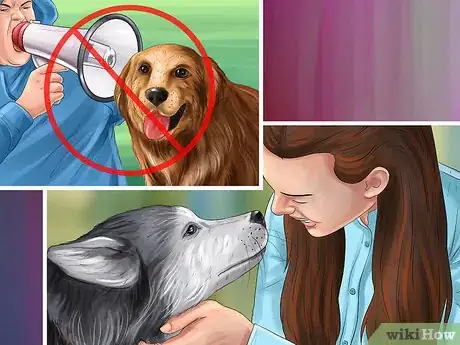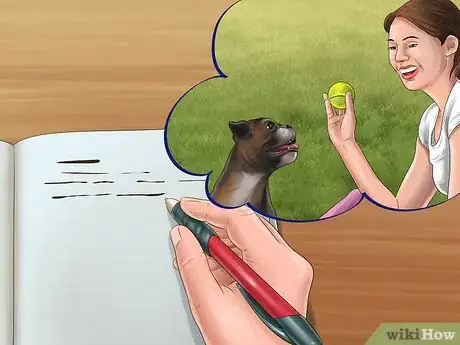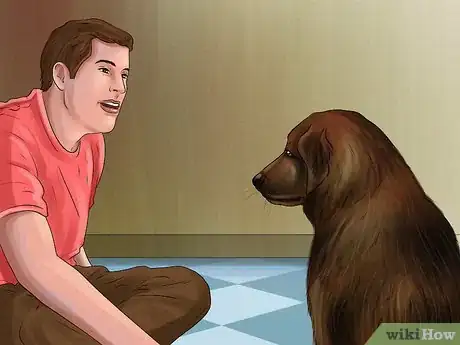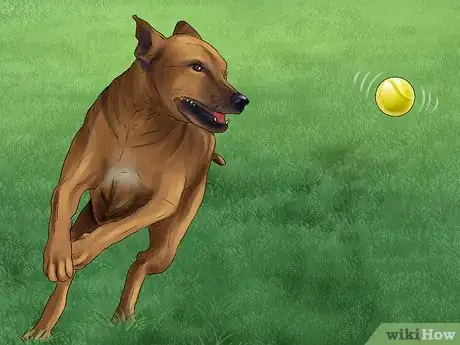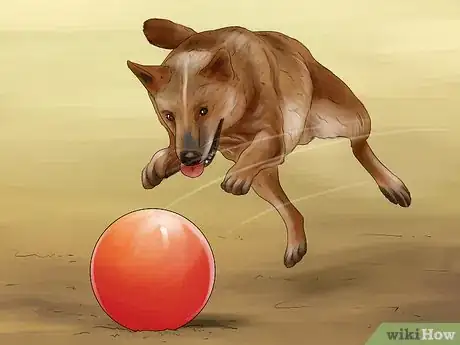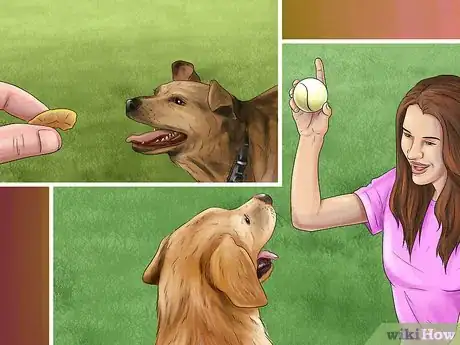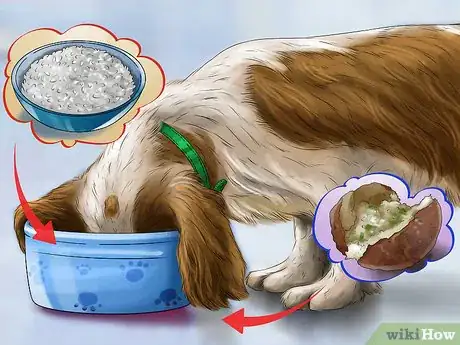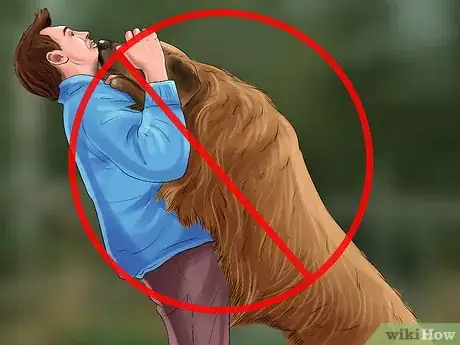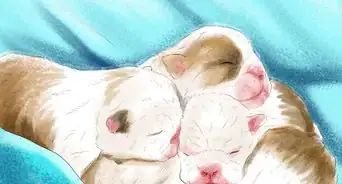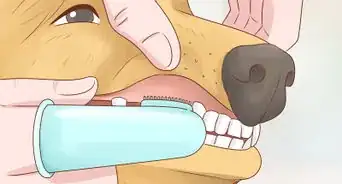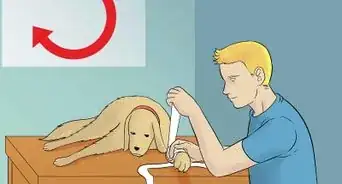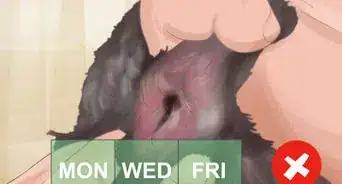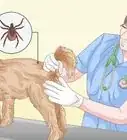This article was co-authored by Dee Hoult. Dee Hoult is the CEO of Applause Your Paws, Inc., South Florida's largest privately-owned dog training company. With over 15 years of experience, Dee specializes in correcting dog behavior problems by providing engaging, positive education and non-intimidating training. Dee holds a BS in Marine Science and Biology and an MBA from the University of Miami. She is a credentialed Certified Professional Dog Trainer through the Certification Council for Professional Dog Trainers and a credentialed Certified Dog Behavior Consultant (CDBC) through the International Association of Applied Behavior Consultants (IAABC). In 2018, Dee was a finalist for Woman of the Year for the Women in the Pet Industry Awards.
There are 19 references cited in this article, which can be found at the bottom of the page.
This article has been viewed 25,538 times.
Dogs are an important part of many families that provide plenty of love and enjoyment. They also need lots of love and enjoyment, which is important to their health and happiness.[1] Dogs crave attention and companionship, which are basic things any pet parent should provide. Some people may not be sure how to give their dogs healthy attention, in some cases smothering dogs or sending a dog outside by itself when it really wants interaction with you.[2] You can give your dog healthy attention by providing it during appropriate times and stimulating it with fun activities.
Steps
Optimizing Your Attention to Your Dog
-
1Be gentle and loving. Any attention you give your dog should always be gentle and loving. This can cultivate a sense of security and stability in your dog and strengthen your bond.[3]
- Praise your dog while giving it attention such as petting or playtime. Use the dog’s name to reinforce your message. For example, “What a fine and good dog you are, Leo! Gimme a shake. Good boy, you’re such a smart dog!”[4]
- Avoid yelling or using loud tones when giving your dog attention. This could cause your dog to be fearful or anxious and may undermine the healthy attention you provide.
-
2Schedule daily playtime.[5] Dogs are pack animals that are not made to spend a lot of time alone.[6] In addition, humans first bred dogs to work. Because of these factors, dogs naturally crave play that simulates work. Enjoying daily playtime with your dog can ensure that your dog gets enough exercise while strengthening your bond through healthy attention.[7]
- Schedule at least 30 to 60 minutes of play with your dog every day. This could be an activity you do together such as running, walking, fetching, catching a Frisbee or ball, or visiting a local dog park.
Advertisement -
3
-
4Reciprocate your dog’s affection. Your dog may show you affection during playtime or other instances, such as after meals. Show your dog that you enjoy its attention by reciprocating its actions. Ways your dog may show its affection for you include:
- Cuddling with you after eating. Cuddling back is a healthy form of attention and love.
- Sleeping with you. You can let your dog lay next to you in bed or in its own bed in the room.
- Approaching you and wagging its tail when you come home. Saying “It’s great to see you, too, Elsa,” followed by petting or a hug gives your dog the attention and love it missed while you were away.
- Sitting with you in your office while you work or “helping” as you prepare dinner. Incorporating your dog into these daily activities is a great way to show attention and affection.[10]
Enjoying Fun Activities with Your Dog
-
1Go for regular walks.[11] Play is one of the best ways to give your dog healthy attention. Regular brisk walks are a feel-good activity that not only strengthen your bond through attention, but also fulfill your dog’s need to travel and explore.[12]
- Aim to walk briskly for 30 to 40 minutes at least once a day and ideally two. This can ensure your dog’s brain releases feel-good hormones.
-
2Play fetch with your dog. Dogs love chasing and retrieving objects. Throw toys across a room or outdoor space for your dog to chase and fetch. This can ensure your dog gets plenty of healthy attention during the day.[13]
- Use items such as medium to large balls or toys on rope. Make sure no item is too small that your dog could swallow it, such as a ping pong or tennis ball.
- Get your dog’s attention before throwing the toy so that it can anticipate where to run. Try faking out your dog by moving one hand in a throwing motion and then saying her name as you toss the toy in the opposite direction.
- Use an exciting voice and give your dog lots of encouragement and praise as you play. For example, “Fetch that ball, Spike! Whoa, you caught it! Great job! Now bring it back to me for another go.”
-
3Have a tug of war. Grabbing and pulling things is a natural canine urge. Taking the time to have a tug of war with your dog provides it healthy attention while also showing affection.[14]
- Use a piece of soft and comfortable material to play tug of war. This could be an old clean rag or a soft piece of rope. Even a piece of bungee material makes a great pull toy. The material should be between one and three feet long.[15]
-
4Do the pounce and shake. Much like cats, dogs also enjoy pouncing and shaking objects. This mimics hunting, which is one of their natural instincts. Giving your dog a squeaky toy on which to pounce and then shake can provide enjoyment. Make sure you praise your dog during pounce and shake play to let it know you’re paying attention.[16]
-
5Offer your dog a chew toy. Some dogs may get bored with play or being petted. If this happens, give the dog a bone—or chew toy. This not only shows your dog attention and love, but also provides entertainment that engages the mouth. Chew toys can also improve a dog’s dental health.[17]
- Get a chew toy made from either natural materials or nylon. You can also offer natural chew toys such as beef bones, rawhide bones, and non-rawhide chews made from vegetables and chicken.
- Consider a chew toy that cleans your dog’s teeth.
-
6Supply toys when you’re gone. It can be difficult to leave your dog at home, but you might need to work or attend school. This can bore your dog from lack of attention and activity. Providing your dog toys can help it beat the boredom and “give” it attention until you get home. Some objects to occupy your dog include:[18]
- Hard rubber toys for chewing and carrying around.
- Rope toys.
- Balls.
- “Busy box” toys with hiding places for snacks.
- Soft, stuffed and/or squeaky toys.
- Dirty laundry that smells like you.
-
7Reward play with treats. As you give your dog attention, remember to praise and reward it. A small treat, such as a bit of kibble, provides extra attention while letting the dog know hat you enjoy its company. Rewards can also strengthen the bond between you and your dog.
Avoiding Unhealthy Attention
-
1Give your dog attention at appropriate times. There are times when dogs want or need alone time and shouldn’t be disturbed. This includes when it is eating or aggressive. Giving your dog attention at the right times can ensure that it is not only healthy, but also strengthens the bond between you and your dog.[19]
- Share love and attention when your dog is in a calm-submissive state. Good times to do this are after your dog has eaten or exercised, changed an unwanted behavior, or responded to a rule or command.
- Use discretion in giving your dog attention if it is whining, begging, or barking. Investigate the cause of the behavior and proceed accordingly. For example, if your dog is barking because it saw a stranger in the yard, offer it some comfort by saying, “It’s ok, Todd, it was just a person dropping off a package.”
- Avoid showing affection if your dog is fearful, anxious, dominant, possessive, aggressive, or breaking a rule.
-
2Establish yourself as pack leader. Dogs in the wild live in the social order of their pack. Your dog will look to you as the leader of its pack. Establishing your dominance can ensure your dog is loved, trained, and lively without being spoiled or uncontrollable. Failing to step into the alpha role may signal to your dog that it is the alpha. This can lead to uncontrollable behaviors such as eating off the table, jumping on others, or an inability to be alone. You can establish yourself as the alpha in your home by:
- Interacting with your dog as if you own it, not in a timid manner.
- Offering praise quickly and warmly.
- Reprimanding it fairly and quickly then move on.
- Making your dog obey on the first command.
- Giving and denying permission.
- Being a model of confidence and authority to your dog.
-
3Stick to mostly dog food. Many human foods such as chips, raw meat, onions, and chocolate can be toxic for dogs.[20] Beyond this, feeding your dog table scraps can lead to undesirable behaviors such as begging or not wanting to eat dog food.[21] Providing dog food and an occasional human treat can help you avoid unhealthy attention and further establish you as pack leader.
- Recognize that an occasional scrap of human food is fine. However, this should be only once in a great while and as praise for something, and shouldn't be given from the table.
- Choose dog friendly treats such as steamed or baked potatoes, plain rice, oatmeal, bits of cooked chicken or turkey, or finely chopped or steamed unseasoned vegetables.
-
4Discourage jumping. Dogs greet each other with nose-to-nose contact. When your dog sees you or guests, it likely wants to give a warm greeting in the same way. However, this can be a dangerous behavior that injures you or your guests, especially if they are children and/or frail adults. Train your dog to do a preferred behavior, such as sitting, to greet and get attention from you and others.[22]
- Give your dog the “sit” command anytime it stands up to greet others. Don’t give the dog any attention until it stays seated.
- Ask your guests to help with the training. Tell them to turn and walk away if your dog isn’t sitting when they arrive. Then repeat, “Sit!” to your dog and let your guests approach it again.
-
5Prevent separation anxiety. Dogs are social animals that live in packs in the wild. As a result, leaving your dog alone can result in separation anxiety, which is common. But separation anxiety can lead to destructive behaviors such as chewing, whining, scratching, and defecation. Preventing separation anxiety is key to avoiding unhealthy attention and bad behavior in your dog. You can prevent separation anxiety by:[23]
- Not making a fuss about leaving or returning.
- Leaving recently worn clothing that smells like you with your dog.
- Establishing a word with your dog that lets it know you’ll be back.
- Confining the dog loosely in a room or crate that simulates a den.
- Providing busy toys for distraction.
Expert Q&A
-
QuestionHow much attention should you give your dog?
 Dee HoultDee Hoult is the CEO of Applause Your Paws, Inc., South Florida's largest privately-owned dog training company. With over 15 years of experience, Dee specializes in correcting dog behavior problems by providing engaging, positive education and non-intimidating training. Dee holds a BS in Marine Science and Biology and an MBA from the University of Miami. She is a credentialed Certified Professional Dog Trainer through the Certification Council for Professional Dog Trainers and a credentialed Certified Dog Behavior Consultant (CDBC) through the International Association of Applied Behavior Consultants (IAABC). In 2018, Dee was a finalist for Woman of the Year for the Women in the Pet Industry Awards.
Dee HoultDee Hoult is the CEO of Applause Your Paws, Inc., South Florida's largest privately-owned dog training company. With over 15 years of experience, Dee specializes in correcting dog behavior problems by providing engaging, positive education and non-intimidating training. Dee holds a BS in Marine Science and Biology and an MBA from the University of Miami. She is a credentialed Certified Professional Dog Trainer through the Certification Council for Professional Dog Trainers and a credentialed Certified Dog Behavior Consultant (CDBC) through the International Association of Applied Behavior Consultants (IAABC). In 2018, Dee was a finalist for Woman of the Year for the Women in the Pet Industry Awards.
Certified Dog Behavior Consultant Most dogs require plenty of attention to stay healthy physically and mentally. If your dog often gets into trouble, this may be a sign they need more exercise and affection.
Most dogs require plenty of attention to stay healthy physically and mentally. If your dog often gets into trouble, this may be a sign they need more exercise and affection. -
QuestionWhy is my dog suddenly acting up?
 Dee HoultDee Hoult is the CEO of Applause Your Paws, Inc., South Florida's largest privately-owned dog training company. With over 15 years of experience, Dee specializes in correcting dog behavior problems by providing engaging, positive education and non-intimidating training. Dee holds a BS in Marine Science and Biology and an MBA from the University of Miami. She is a credentialed Certified Professional Dog Trainer through the Certification Council for Professional Dog Trainers and a credentialed Certified Dog Behavior Consultant (CDBC) through the International Association of Applied Behavior Consultants (IAABC). In 2018, Dee was a finalist for Woman of the Year for the Women in the Pet Industry Awards.
Dee HoultDee Hoult is the CEO of Applause Your Paws, Inc., South Florida's largest privately-owned dog training company. With over 15 years of experience, Dee specializes in correcting dog behavior problems by providing engaging, positive education and non-intimidating training. Dee holds a BS in Marine Science and Biology and an MBA from the University of Miami. She is a credentialed Certified Professional Dog Trainer through the Certification Council for Professional Dog Trainers and a credentialed Certified Dog Behavior Consultant (CDBC) through the International Association of Applied Behavior Consultants (IAABC). In 2018, Dee was a finalist for Woman of the Year for the Women in the Pet Industry Awards.
Certified Dog Behavior Consultant It's possible you aren't giving your dog enough attention. Try spending extra time playing with and cuddling your dog to see if this helps.
It's possible you aren't giving your dog enough attention. Try spending extra time playing with and cuddling your dog to see if this helps.
References
- ↑ Dee Hoult. Certified Dog Behavior Consultant. Expert Interview. 15 September 2020.
- ↑ http://www.humanesociety.org/animals/dogs/tips/dog_care_essentials.html?referrer=https://www.google.com/
- ↑ http://moderndogmagazine.com/articles/healthy-affection-vs-obsession/760
- ↑ http://www.pawculture.com/tips-advice/bonding/15-surefire-ways-to-bond-with-your-cat/
- ↑ Dee Hoult. Certified Dog Behavior Consultant. Expert Interview. 15 September 2020.
- ↑ http://moderndogmagazine.com/articles/healthy-affection-vs-obsession/760
- ↑ http://pets.webmd.com/dogs/guide/exercise-dogs
- ↑ Dee Hoult. Certified Dog Behavior Consultant. Expert Interview. 15 September 2020.
- ↑ https://www.cesarsway.com/dog-psychology/pack-leader/how-to-get-a-dog-to-trust-you
- ↑ http://www.caninemind.co.uk/dogsneeds.html
- ↑ Dee Hoult. Certified Dog Behavior Consultant. Expert Interview. 15 September 2020.
- ↑ http://www.caninemind.co.uk/dogsneeds.html
- ↑ https://www.bluecross.org.uk/pet-advice/how-play-your-dog
- ↑ https://www.bluecross.org.uk/pet-advice/how-play-your-dog
- ↑ http://pets.webmd.com/dogs/teaching-your-dog-to-play-tug-of-war
- ↑ http://pets.webmd.com/dogs/teaching-your-dog-to-play-tug-of-war
- ↑ http://www.drsfostersmith.com/pic/article.cfm?aid=241
- ↑ http://www.caninejournal.com/why-dogs-eat-grass/
- ↑ https://www.cesarsway.com/dog-psychology/exercise-discipline-affection/exercise-discipline-affection
- ↑ http://www.aspca.org/pet-care/animal-poison-control/people-foods-avoid-feeding-your-pets
- ↑ http://www.dogingtonpost.com/why-table-scraps-are-bad-for-dogs/
- ↑ http://www.humanesociety.org/animals/dogs/tips/jumping_up.html?referrer=https://www.google.com/
- ↑ http://www.humanesociety.org/animals/dogs/tips/separation_anxiety.html
- ↑ Dee Hoult. Certified Dog Behavior Consultant. Expert Interview. 15 September 2020.
About This Article
To give your dog healthy attention, try and schedule 30 to 60 minutes of playtime a day, such as walking or playing fetch, to strengthen your bond. Try to be gentle and loving with your affection, instead of making loud noises or being rough, to help your dog feel calm and safe. If it shows you affection at convenient times, like after eating or before bed, cuddle and pet it so it knows you enjoy the intimacy. On the other hand, you should discourage your dog from jumping up by telling it to sit, since it will think this is okay with other people. For more tips from our Veterinary co-author, including how to keep your dog entertained while you’re away, read on!

